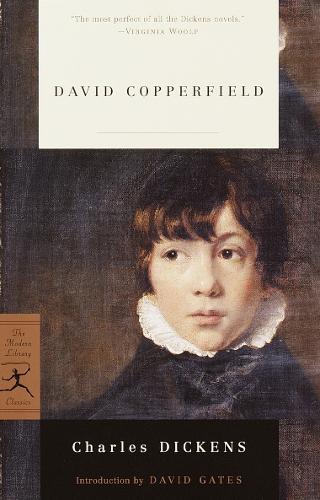
David Copperfield
(Paperback)
Available Formats
Paperback
Published: 1st May 2012
Paperback
Published: 16th July 2012
Hardback
Published: 25th June 2014
Paperback
Published: 5th May 1992
Paperback
Published: 15th March 1988
Paperback
Published: 1st July 2008
Paperback
Published: 7th February 2006
Paperback
Published: 1st May 2005
Hardback
Published: 13th September 2016
Hardback
Published: 3rd April 2017
Hardback, New edition
Published: 13th September 2019
Paperback
Published: 26th September 2012
Paperback
Published: 15th December 2000
Hardback
Published: 2nd December 1991
Hardback
Published: 5th June 2019
Hardback
Published: 25th June 2024
Paperback
Published: 3rd September 2019
Publishing Details
David Copperfield
By (Author) Charles Dickens
Introduction by David Gates
Random House USA Inc
Modern Library Inc
15th December 2000
United States
Classifications
General
Fiction
Literary studies: fiction, novelists and prose writers
Literary studies: c 1800 to c 1900
823.8
Short-listed for BBC Big Read Top 100 2003
Physical Properties
Paperback
896
Width 133mm, Height 201mm, Spine 41mm
624g
Description
Hugely admired by Tolstoy, David Copperfield is the novel that draws most closely from Charles Dickens's own life. Its eponymous hero, orphaned as a boy, grows up to discover love and happiness, heartbreak and sorrow amid a cast of eccentrics, innocents, and villains. Praising Dickens's power of invention, Somerset Maugham wrote: "There were never such people as the Micawbers, Peggotty and Barkis, Traddles, Betsey Trotwood and Mr. Dick, Uriah Heep and his mother. They are fantastic inventions of Dickens's exultant imagination...you can never quite forget them."
This Modern Library Paperback Classics edition includes a new Introduction by Pulitzer Prize finalist David Gates, in addition to new explanatory notes.
Reviews
"The most perfect of all the Dickens novels."
--Virginia Woolf
Author Bio
Charles Dickens was born in a little house in Landport, Portsea, England, on February 7, 1812. The second of eight children, he grew up in a family frequently beset by financial insecurity. At age eleven, Dickens was taken out of school and sent to work in London backing warehouse, where his job was to paste labels on bottles for six shillings a week. His father John Dickens, was a warmhearted but improvident man. When he was condemned the Marshela Prison for unpaid debts, he unwisely agreed that Charles should stay in lodgings and continue working while the rest of the family joined him in jail. This three-month separation caused Charles much pain; his experiences as a child alone in a huge citycold, isolated with barely enough to eathaunted him for the rest of his life.
When the family fortunes improved, Charles went back to school, after which he became an office boy, a freelance reporter and finally an author. With Pickwick Papers (1836-7) he achieved immediate fame; in a few years he was easily the post popular and respected writer of his time. It has been estimated that one out of every ten persons in Victorian England was a Dickens reader. Oliver Twist (1837), Nicholas Nickleby (1838-9) and The Old Curiosity Shop (1840-41) were huge successes. Martin Chuzzlewit (1843-4) was less so, but Dickens followed it with his unforgettable, A Christmas Carol (1843), Bleak House (1852-3), Hard Times (1854) and Little Dorrit (1855-7) reveal his deepening concern for the injustices of British Society. A Tale of Two Cities (1859), Great Expectations (1860-1) and Our Mutual Friend (1864-5) complete his major works.
Dickenss marriage to Catherine Hoggarth produced ten children but ended in separation in 1858. In that year he began a series of exhausting public readings; his health gradually declined. After putting in a full days work at his home at Gads Hill, Kent on June 8, 1870, Dickens suffered a stroke, and he died the following day.
